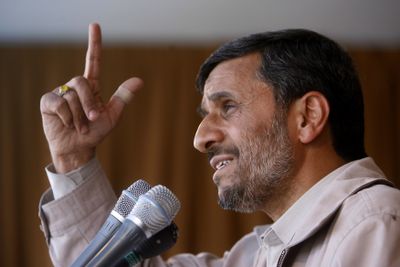Iran missile firing seen as advance
Ahmadinejad says his nation ‘running the show’

SEMNAN, Iran – Iranian President Mahmoud Ahmadinejad announced Wednesday that his country had successfully test-fired a medium-range missile apparently capable of striking Israel and U.S. bases in the Persian Gulf region.
U.S. officials confirmed the launch, while arms-control experts debated its significance. Several described it as evidence of continuing progress in Iran’s missile program, if not a breakthrough. Iran fired a similar rocket last year.
The missile was launched from a site in Semnan province, where Iran’s missile and space programs are headquartered and Ahmadinejad was born. Ahmadinejad visited the province Wednesday as part of a series of trips by government officials to Iran’s 30 provinces ahead of the June 12 presidential election.
Reporters touring with Ahmadinejad saw corkscrews of smoke on the horizon near the Alborz mountain range early Wednesday. Hours later, Ahmadinejad announced the news to a crowd of thousands of people gathered for a speech in the city of Semnan.
“The rocket went into space, returned to Earth and hit its target,” he said to raucous cheers in a soccer stadium lined with posters of himself.
Ahmadinejad has long said Iran’s nuclear program has strictly peaceful civilian purposes. But on Wednesday, he linked the missile test with that program, calling it an important scientific achievement and a blow to those trying to thwart Iran’s nuclear ambitions.
“In the nuclear case, we send them a message: Today the Islamic Republic of Iran is running the show,” Ahmadinejad said in his speech.
Gary Samore, the top White House counter-proliferation official, said the missile was “a significant step forward in terms of Iran’s capability to deliver weapons.”
But some experts said the missile was a new version of an existing missile that was successfully tested late last year and has a range of about 1,200 miles.
“The last launch, in November, didn’t work as well, so here we have what appears to be a series of tests to try to master the technology and make it better,” said David Albright, a former U.N. weapons inspector and president of the Institute for Science and International Security.
Iran’s ability to build a solid-fuel rocket suggests an increasing sophistication in its missile program, because solid fuel offers advantages over Iran’s previous liquid-fuel program, several experts said. For one thing, liquid-fuel rockets are more vulnerable to pre-emptive strikes because it takes hours or even days to fuel them. Solid-fuel rockets can be launched faster and are more mobile, the experts said.
According to the Iranian government, the missile showed another technical development: It was in two stages, rather than one.
Samore said the launch might strengthen the coalition of countries that has been trying to restrain Iran’s nuclear program.
“It actually helps us make the case to countries like Russia which have been skeptical in the past” of the danger of Iran’s weapons programs, Samore told a lunch of the Arms Control Association.